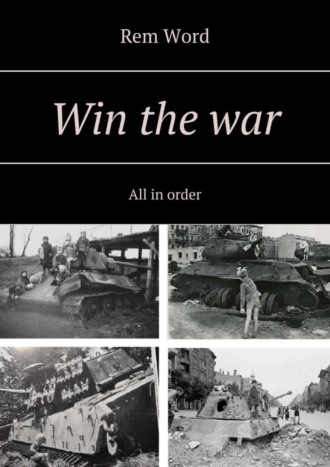
Полная версия
Win the war. All in order
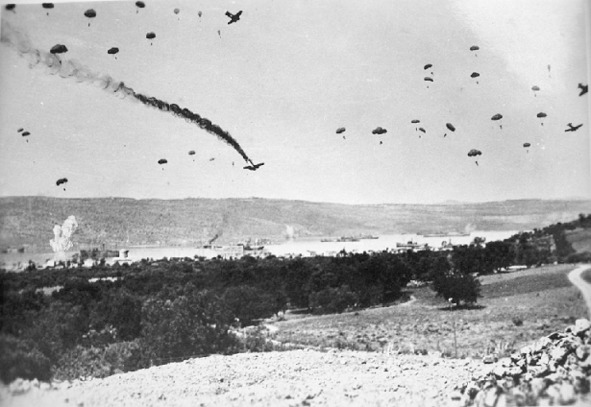
In the battle for Crete (May 20—31, 1941) elite skydivers are the decisive force. On both sides die 5 thousand people. More than 5 thousand Greeks and 12 thousand allies (British, New Zealanders, Australians) are captured. The operation is generally successful. However, since then the German command has abandoned the practice of large landing forces. This decision allows the UK to preserve the strategically important island of Malta
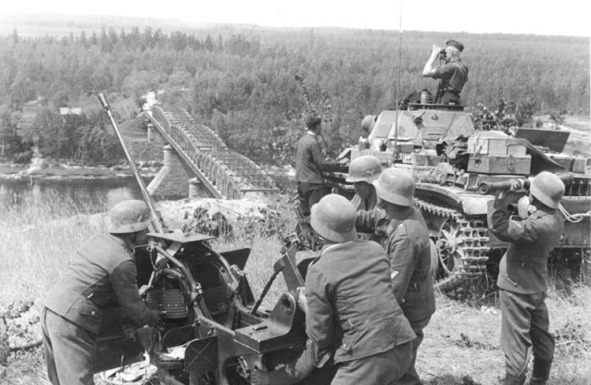
Calculate the forces of the parties in the Battle of the Titans. The population of the Soviet Union in the census of 1939 is 170 million. The census leaders of 1937, which showed the result of «only» 162 million for the «undercounting» of the population were shot. In 1940, territories with a population of 18 million people, which were not always loyal to the new system, were attached to the USSR. We will assume that the results of the «firing» population census are correct. Then, by 1941, the population of the colossus was 180 million people. The Third Reich, 1941, i.e., Germany, Austria, the Sudetenland and other territories inhabited by ethnic Germans subject to conscription – 90 million people. Hungary – 9.3 million (800,000 Hungarians were killed on the Eastern Front), Romania – 20 million (453,000 died). These two countries are the unconditional allies of Germany, whose human reserves she is free to dispose of as her own. The contingent of volunteers in 64 thousand is allocated by 44 million Italy (during the war years the corps was updated several times, 374 thousand died), and also 25 million Spain – 18 thousand (15 thousand dead). Slovakia – 36 thousand, 3 thousand died, Croatia 2 thousand people, the number of dead is unknown, Finland – 300 thousand people, 70 thousand losses (against 108 thousand Soviet casualties on this front, including 18 thousand dead in captivity)The Wehrmacht also owns the resources and industry of France, Norway, Belgium, Holland, Denmark, Poland, Greece, Bulgaria, Yugoslavia and the Czech Republic. Photography – German soldiers on the border with the Soviet Union are conducting a reconnaissance, June 21, 1941. On the left – 20 mm. automatic anti-aircraft gun 2 cm FlaK 30, on the right – an early-release T-4 tank, with 75 mm. the instrument
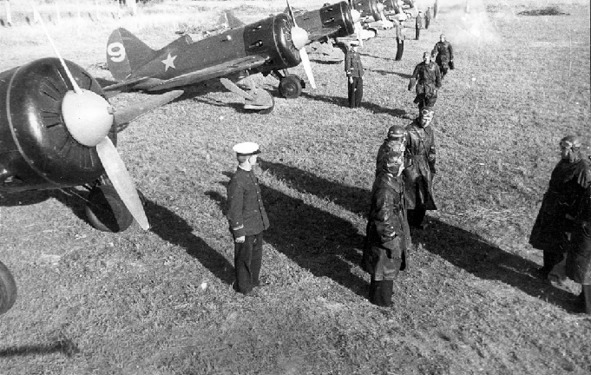
The only ally of the USSR at this moment is the 47-million Great Britain with 1.2 million (including the units located in the colonies), the army pretty battered after Dunkirk. Her war with Germany until 1944 is similar to a ritual battle, a knightly tournament, where, according to the established rules, knights hung with glands seize. England has one and a half thousand aircraft, a dozen aircraft carriers, many cruisers, destroyers and submarines. After Dunkirk, the British have no more than 100 tanks left, but, thanks to developed industry, their number is constantly increasing. Fighting here rather technique, not people. The interest of Germany, whose spirit is now ruled by the ancient Germanic gods, lies in the Northeast. According to the plans of the command, German colonies should be organized in the USSR on the model of Ancient Sparta, with an autochthonous population reduced to 50 million. In the photo – Soviet pilots near fighters I-16.
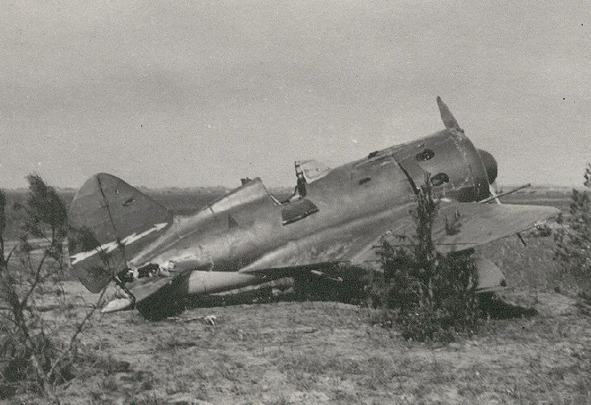
On June 22, 1941, Germany and Romania entered the war with the USSR. The basis of military operations for Bucharest is the rejection of Bessarabia and Northern Bukovina a year earlier. A day later, Slovakia is included in the war. On the night of June 26, the Hungarian city of Kosice, three years previously owned by Slovakia, was bombarded by unmarked aircraft. 27 tons of bombs dropped. It is still not known whether the Soviet air force that bombed the city because of the confusion was German or even Romanian (to push an ally to action), but on June 27, Hungary declares war on the USSR. At the same time, on June 25, Soviet aviation strikes 18 Finnish airfields. Some of them are really based on German aircraft. On the same day, Suomi declares war. By the end of the year, it is occupying a significant part of Karelia, including the capital Petrozavodsk (which has become Eyslynnom). About 70,000 civilians from non-Finnish peoples fall into concentration camps. One third of them will die of malnutrition, disease, and mistreatment. A photograph is a Soviet I-16 fighter that failed to take off (or made an emergency landing). The curb weight of the aircraft 1,300 kg., The speed of 450 km. hours, the range of 480 km., weapons – two machine guns 7.62 mm. Produced about 10,000 units. The second half of June 1941, USSR
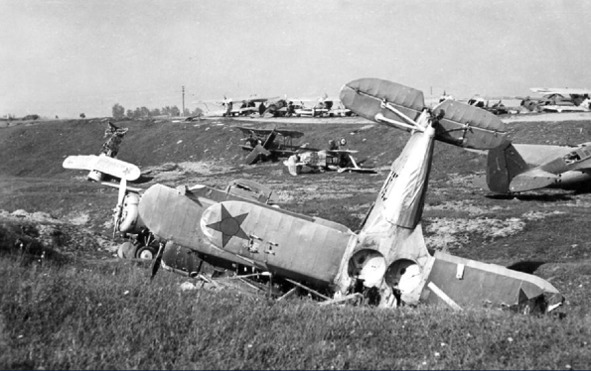
Soviet fighters shot down at takeoff, I-15 and I-16, June 22, 1941
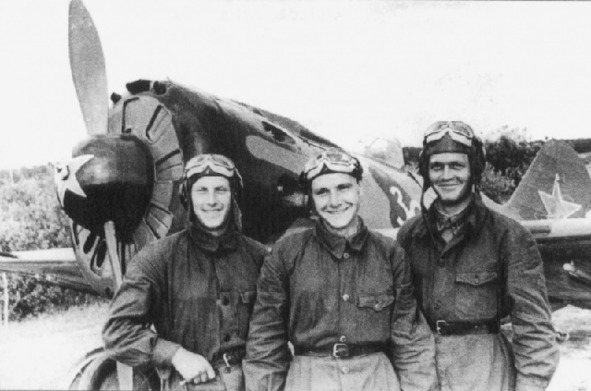
The «Decree of military jurisdiction of the Barbarossa Plan dated May 13, 1941 states:“ For the actions that Wehrmacht officials and allies will perform against the enemy civilian population, no prosecution is provided, also if this action is simultaneously a war crime or misdemeanor… I release you from the chimera called conscience. "Further: «I reject Christianity, because it is a product of Judaism, because it is internationalistic and because it preaches peace on earth.»(Adolf Gitler). In the pre-war photo – military pilots of the USSR near the I-15. These people will have to understand what a total war is and do the impossible.
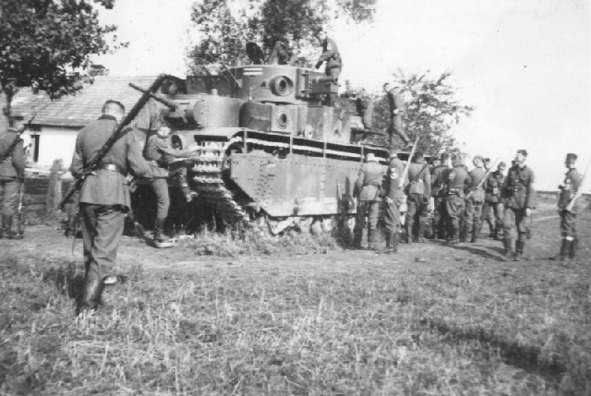
On June 23, 1941, the battle for Dubno-Lutsk-Brody (320 km west of Kiev) starts. G. Zhukov, who came to the scene of the events, rejects the idea of the chief of staff of the South-Western Front about withdrawing troops. The new plan is a strike by five mechanized corps of 2,800 (later 3,100) tanks in four (later – five) German tank divisions, 720 tanks and 70 assault guns. Photography – German soldiers inspect abandoned heavy tank T-35. Weight 50 tons, 11 crew members, booking – 30 mm front body., 20 mm board., 20 mm towers. The speed over rough terrain is 10—12 km. h. Armament – one 76.2 mm., two 45 mm. guns and six-seven machine guns. Made 59 units. Until June 1941, these tanks were not involved in the fighting, limited only by the demonstration of the power of the Soviet Union at military parades.

Wehrmacht formations, in addition to armored vehicles, include large units of infantry, artillery, and qualified repair brigades. The bulky (400 tanks) mechanized corps of the Red Army make marches of 300 km each, losing at least one third of the vehicles from mechanical damage. The Soviet production system of the equipment does not seem to provide for the delivery, which is not worth even a half-word, «small things» for repair. Guidelines for driving and maintenance of new tanks, at this time – are classified even from the driver. Sometimes, so carefully stored by the crews of the car, at a crucial moment refuel not with diesel fuel, but with gasoline. In order to avoid equipment breakdowns and charges of sabotage, grassroots commanders sabotage real military training. The fact that in the German educational units is punished with reprimand, in the Red Army can end with execution. The photograph shows Soviet BT-7 tanks damaged and abandoned by crews. Weight 14 tons, crew 3 people., Booking 15—20 mm., Cannon 45 mm., 1—3 machine guns. Speed, according to the designers, is the main advantage of the «high-speed» tank. On tracks, on the BT-7 highway, it develops 52 km. hours, on wheels – an unthinkable 72 km. h
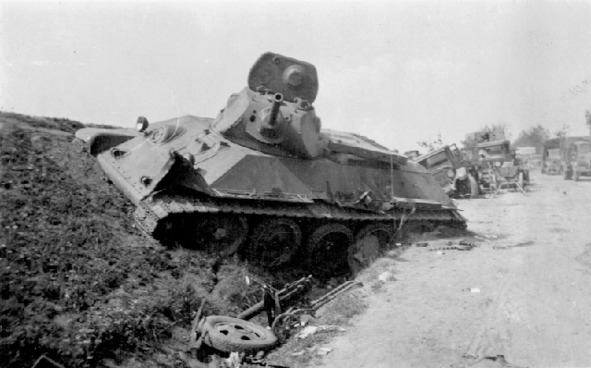
In a society of formal equality and «territorial organization of the community,» any insignia is qualified as belonging to a particular caste. The commander of the Red Army at any cost seeks to secede from the masses of soldiers. These maxims agree with the observations of the author during his military service in the Soviet and then Russian army. The German army from the middle of the nineteenth century implies, with strict observance of the chain of command, the attitude of the officer to the soldier as an equal. Cohesion, trust, even if, as they say, on the basis of blood-related ties, determines a high level of governance. Photography – T-34-76 tank as part of a broken Soviet column. June-July 1941. The mass is 26 tons, the crew is 4 people, the armor is 45 mm in all directions (feed 40 mm.) The gun is 76 mm., Course and twin machine guns. The speed on the highway is 54 km. hours, rugged terrain – 36 km. h. if you manage to stick the transfer
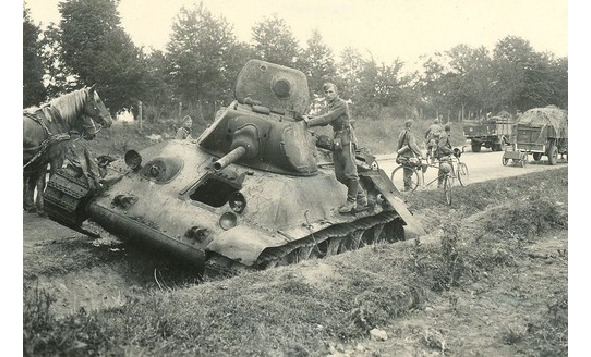
So, tank battles, frontal attacks on the positions of German anti-tank guns, maneuvering without communications and maps, separation from supply and repair lines occur near Kiev. Total. By June 30, the Red Army lost 2,600 tanks, the Wehrmacht – 170 (irrevocably). The southwestern front collapses.Photography – a German soldier inspects a damaged T-34-76 tank on the sidelines. The surroundings of Kiev, July 1941
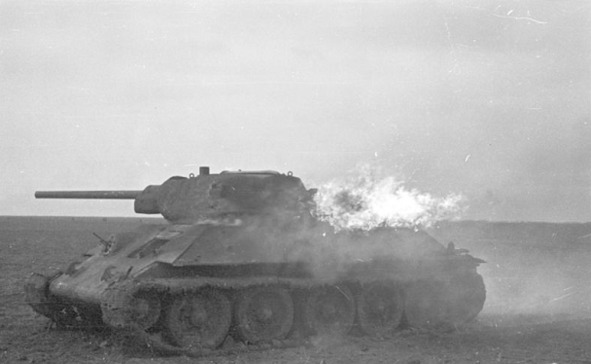
Stalin has to put aside executions, empty slogans, and work with the problem, now really delving into the essence of what is happening. The control system is being rebuilt. It works from the second half of 1942 to May 1945, and for two and a half years it allows us to escape from the collapse to victory.Photography – burning T-34-76. At this stage of the war, "steel monsters" still do not impress the top officers of the Wehrmacht. The Red Army has by this time only 60 trained crews for the T-34. Battle for Dubno-Lutsk-Brody. Summer 1941

Kiev strategic defensive operation. Summer 1941. Retreating and confused Soviet soldiers
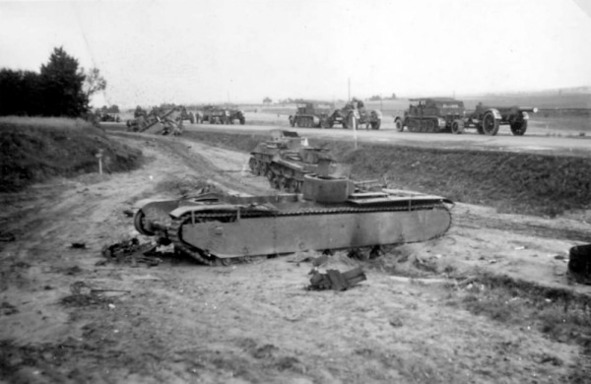
German cars and armored vehicles follow the T-38 tank with four towers removed from the hull. Ukraine, August 1941
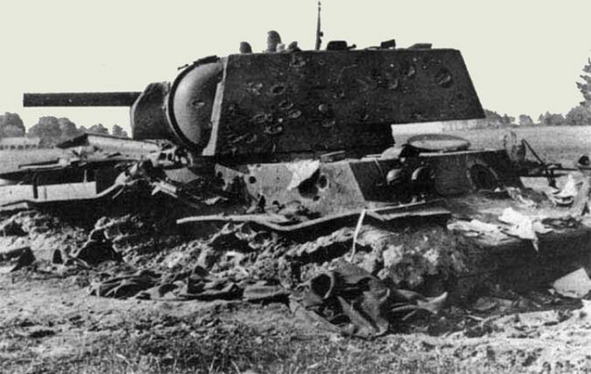
A Soviet tank KV-1 defeated by dozens of shells. July 1941, south of the USSR. Armament: 76 mm. a cannon, 90—114 shells, three 7.62 machine guns. Reservations: forehead, body side 75 mm., Forehead, side turret 75 mm. (protection against armor-piercing projectile 50 mm. German cannon further 200 meters). The crew of 5 people. Weight 48 tons. Transmission problems are common. The speed on the highway is 34 km. h.. Cruising range over rough terrain 120 km. Specific power 11.6 hp, pressure on the ground 0.77 kg. cm. From 1939 to 1942 produced 2770 cars.
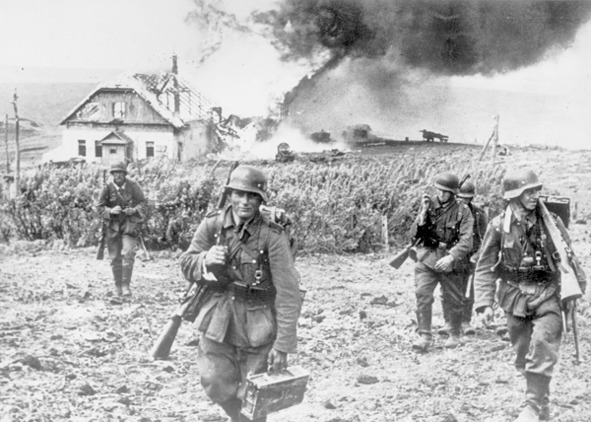
German soldiers in the offensive. USSR, summer 1941
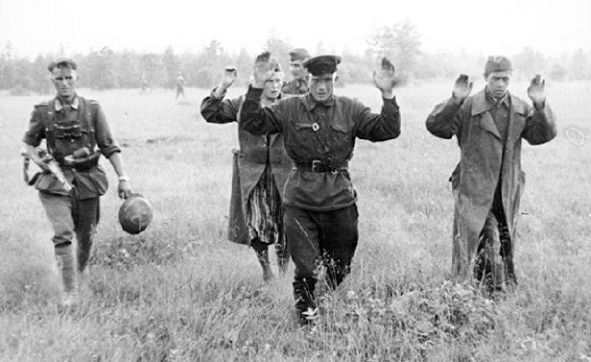
Captured Soviet soldiers. Summer 1941

Captured in the Kiev boiler soldiers of the Red Army. From the memoirs of Vasily Ivanov, a former prisoner of war: «… Another question, also generated by hunger, was the question of who eats the food that is given out. Some said that they are eating now – as soon as they receive, since they can hardly wait for this moment. Others said that it is better to divide each diet into 2 times. After all, then you will eat 6 times a day, not three. And one said that he collects all 3 rations together and eats them after receiving the last teaspoon. – And I eat all this for almost 8 hours, and therefore I don’t feel hunger a third of the day, and I sleep almost 10 hours a day. What only mental phenomena did not cause hunger. In the camp appeared typhus, which spread rapidly, besides this, there was some kind of epidemic of diarrhea… In addition to these diseases, signs of illness of prisoners of scarf began to appear in March of 42 years. The grass that appeared at the camp’s territory in the end of March was quickly destroyed by prisoners. She was eaten both raw and boiled. The prisoners, wanting to pick herbs, which remained only under the beginning of the wire fence, thrust their heads and hands towards her. And the soldiers and officers walking behind the wire fired pistols at the heads. If in December – January, 25—30 prisoners died daily, in March, 40, in April, 75—80, and so on. The dead were demolished in the morgue in stripped form, and at the end of the day they were immersed in carts and taken to the cemetery, where a deep, large moat was dug. The dead were dumped into this ditch, and they began to dig in only upon the arrival of warm days. By May, only half of 9,000 POW commanders survived. In the second camp of captured privates, in which in December 1941 there were about 7,000, in the month of June only 700 people were taken to work, and the camp was closed.
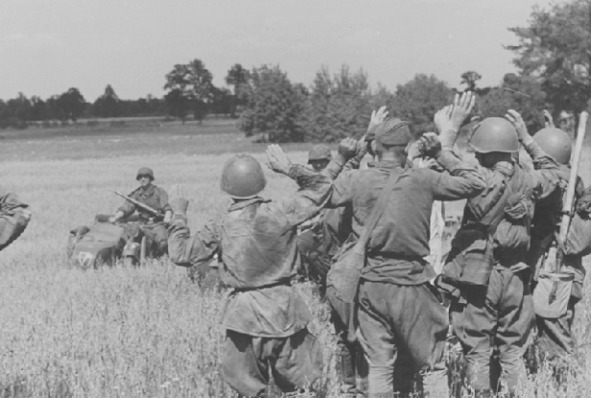
Kiev outskirts, 1941

After the fight in the Kiev boiler. In the background, for the dead soldiers – the Soviet tank BT-7
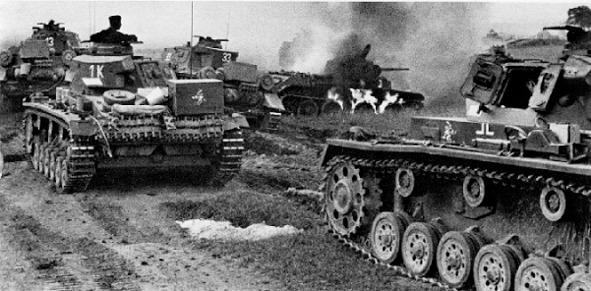
German armored and burning T-34-76. Ukraine, 1941
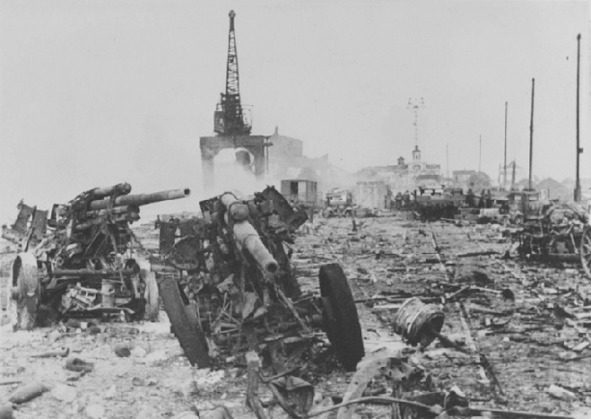
Hot August 13, 1941 Odessa leaves the last train echelon. The defense of a large Black Sea town is successful, but the Headquarters of the Commander-in-Chief decides on the evacuation of troops to the Crimea. The losses of the Soviet and allied German-Romanian troops are equal – 18 thousand people each
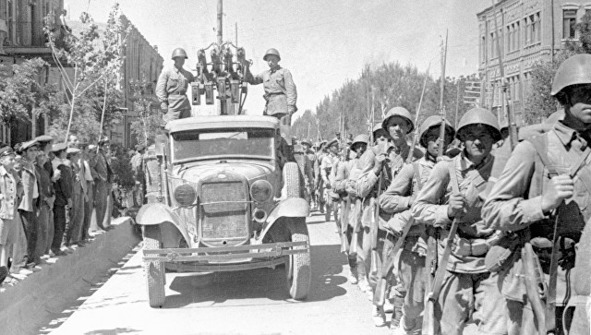
The Anglo-Soviet invasion of Iran (Operation Consent) will take place on August 25, 1941. Without declaring war, the forces of the British Empire attack the Shah’s army from the Persian Gulf. Soviet units invade Transcaucasia. The main strike force of the Red Army is a thousand T-26 tanks, the Caspian flotilla, the British – the fire of naval artillery and the Air Force. Major cities, including Tehran, are being bombarded. Hundreds of civilians die. The Iranian army is densely saturated with money, but it is even more corrupt. Iranian divisions lose control (senior officers tend to leave the battlefield), crumble, surrender. Some units intend to fight to the end. However, on August 29, the Shah gave the order to lay down their arms. In the photo – the Soviet military convoy enters the city of Tabriz.
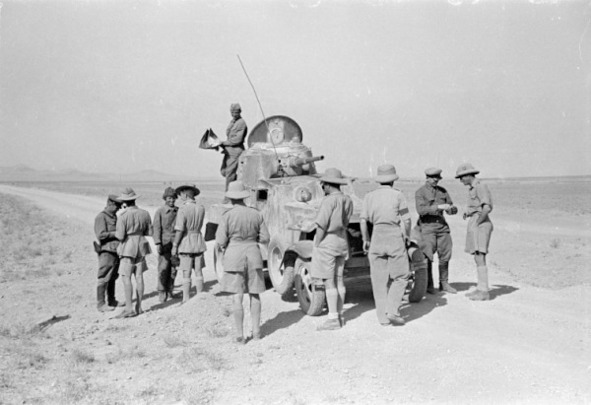
Already on September 17, the Red Army and British units occupy Tehran. A month later, having formed a loyal government (now no side unrelated to the Germans), the Allies leave the capital. The country is divided into Soviet and British zones of influence. According to the treaty, Iran is declared an ally of Britain and the USSR. The parties pledge to withdraw troops within six months after the cessation of all hostilities. This operation has a background. Great Britain is occupying Iraq. The course of action. May, 1941, landing of the expeditionary corps in Basra, air force strikes on airfields. The Germans are trying to come to the aid of the allies, but without the proper enthusiasm and scale. As a result, the British establish control over the oil fields, and in the future they get the opportunity to conduct a corridor for deliveries to the USSR. Photography – Soviet and British officers (in characteristic shorts and cork helmets) communicate near the armored car. Iran, August 1941

The loss of the parties in the Anglo-Iraq war. Britain – 1,200 people, 30 aircraft, Iraqis – 8,500 troops, 20 German, 4 Italian aircraft. Losses during the occupation of Iran: the USSR – 50 people irrevocably, 3 aircraft. Britain – 25 fighters, 8 aircraft. Iran – 800 soldiers, 300 civilians. The result of the operation «Consent» is unhindered delivery of more than 5 million tons of military cargo to the USSR. A small bonus – a significant part of the grain harvest in Northern Iran is being used by the army. But now, in the autumn of 1941, the capture of a considerable country of the East seems only a small drop of honey in a huge barrel of tar.Photography – British correspondent talks with a Soviet officer who was injured during the battle with Iranians
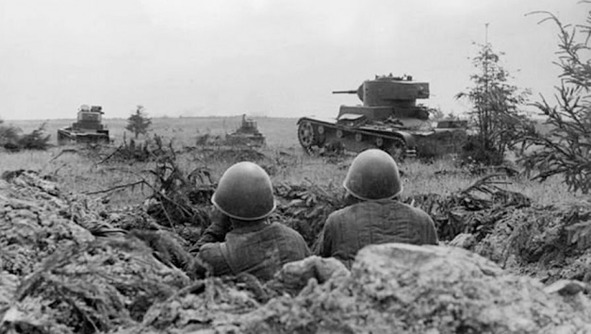
The defense of Soviet troops near Smolensk, 1941, July 10 – September 10. T-26 tanks in the background
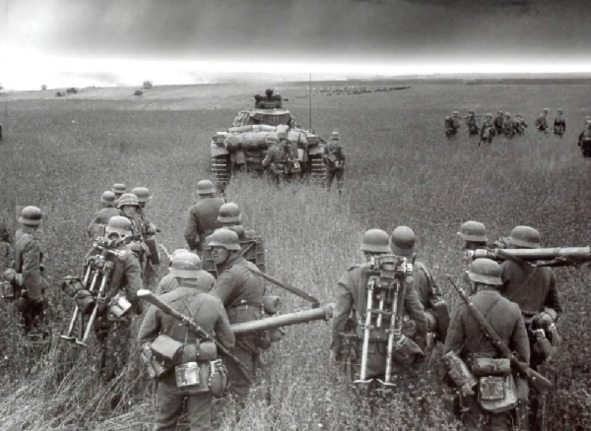
The onset of the fascist German troops near Smolensk, autumn 1941. Infantry with all the tackle equipment, mortar gunners and the first T-4 tank releases
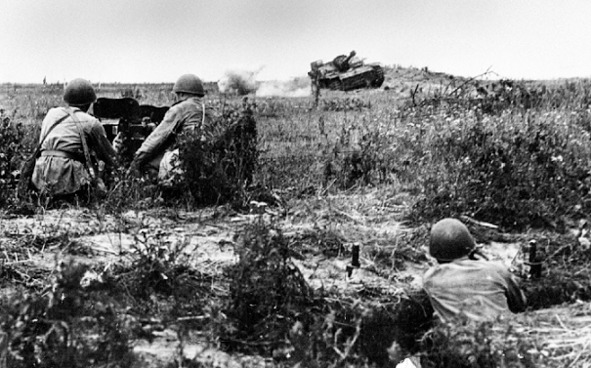
Soviet gunners with 45 mm. a cannon. The outskirts of Smolensk, autumn 1941. In the background – a padded German self-propelled gun
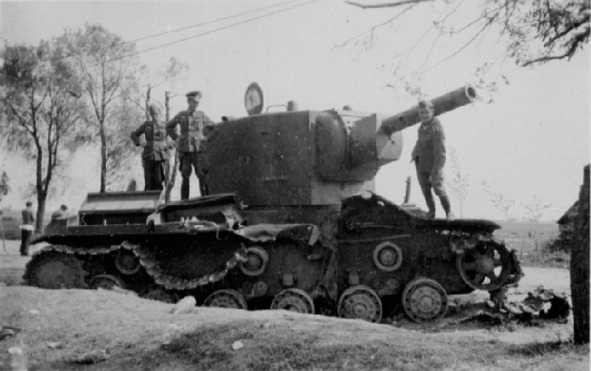
German military inspect the Soviet KV-2 tank with a broken chassis. Even without enemy shells, the overloaded KV-1 and KV-2 chassis often fail. Memories of German corporal Helmut Claussmann: «… Once in our division a soldier was shot, who wrote a defeat letter home in which he scolded Hitler. And after the war, I learned that during the war years, for such letters, several thousand soldiers and officers were shot! One of our officers was demoted to the rank and file for „defeatist talk“. Especially feared members of the NSDAP. They were considered informers, because they were very fanatically minded and could always submit a report to you on command. There were not very many of them, but they were almost always not trusted. Attitude to the local population, to the Russians, to the Belarusians was restrained and suspicious, but without hatred. We were told that we must defeat Stalin, that our enemy is Bolshevism. But, in general, the attitude towards the local population was correctly called „colonial.“ We looked at them in the 41st as a future labor force, as in the territory that would become our colonies. Ukrainians treated better. Because the Ukrainians greeted us very cordially. Almost like liberators. Ukrainian girls easily romances with the Germans. In Belarus and Russia, this was rare. There were contacts on the ordinary human level. In the North Caucasus, I was friends with the Azerbaijanis, who served as auxiliary volunteers (khivi). In addition to them in the division served Circassians and Georgians. They often cooked kebabs and other dishes of Caucasian cuisine. I still love this kitchen very much. From the beginning, they took a little. But after Stalingrad, every year they became more and more. And by the 44th year they were a separate large auxiliary unit in the regiment, but they were commanded by a German officer. We called them Schwarze for their eyes – black. They explained to us that it was necessary to them, as comrades, that they were our assistants. But a certain distrust of them, of course, remained. They were used only as providing soldiers …»
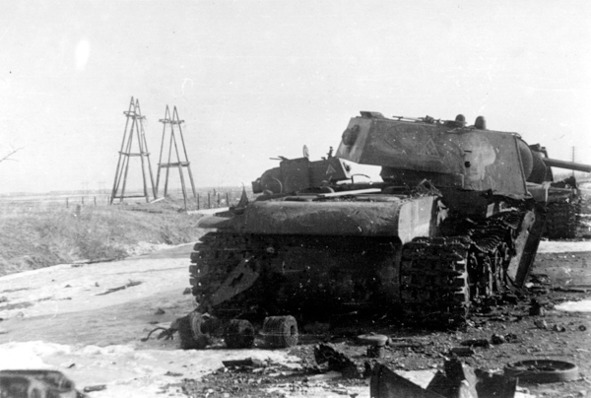
Overwhelmed, probably by a bomb hit, KV-1. The advantage of the Wehrmacht at this stage is high coordination between the branches of the military. As part of the infantry, tank, and other units necessarily have aircraft manufacturers, guiding the Luftwaffe on target.
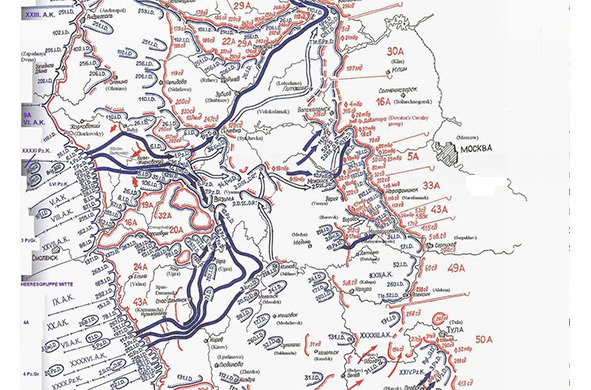
Vyazemsky defensive operation, October 2—13, 1941. Catastrophe. To the west of Vyazma, the forces of Army Group «Center» surround four Soviet armies. The irretrievable loss of the Red Army – 250 thousand people, and 600 thousand prisoners. Losses Wehrmacht unknown. Now only scattered small Red Army detachments remain before Moscow
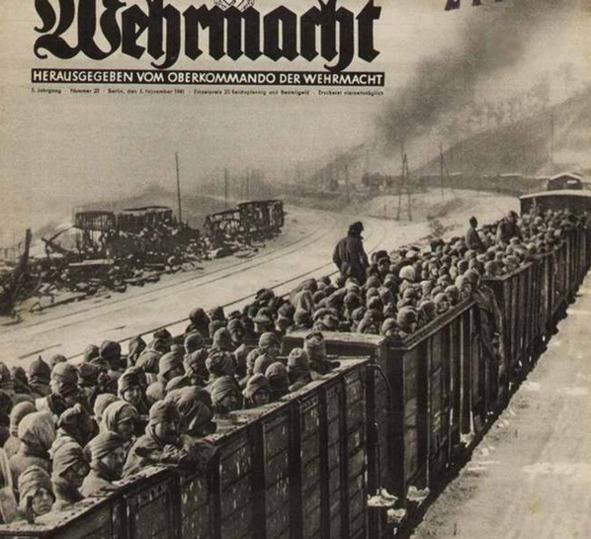
Carried in freight cars like cattle, soldiers captured in the Vyazma boiler. Photo on the cover of a German newspaper. October 1941
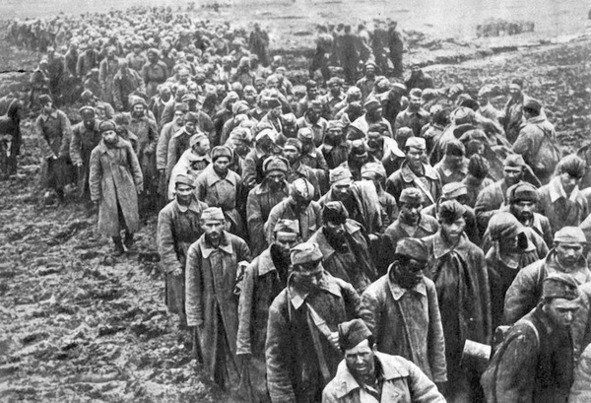
Captured from Vyazemsky boiler. Autumn 1941
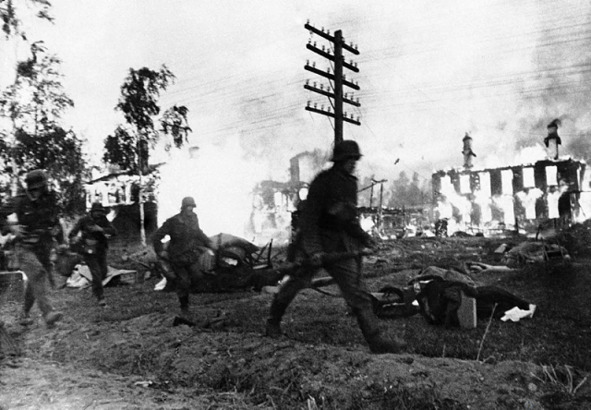
Soldiers of Army Group North in the suburbs of Leningrad. The offensive is somewhat delayed. Residents of the city manage to create the necessary fortifications. Defense effectively keep heavy tanks KV-1 and KV-2, manufactured by the Kirov plant
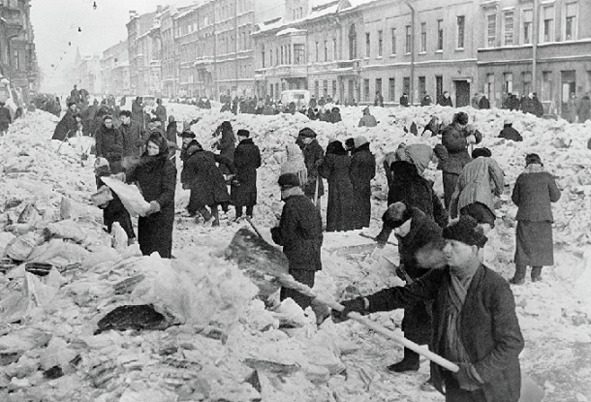
September 8, 1941 Leningrad, the second largest and most important city of the USSR, as well as the surrounding areas are surrounded. The rates of distribution of bread, the main or only food in the first two months are reduced five times. Since November 20, the minimum bread-making rate (for employees, children and dependents) is 125 g. We will read several pages from the story of front-line writer Nikolai Nikulin («Memories of War»). «… In the spring of 1941 in Leningrad, many felt the approach of war. Informed people knew about her preparation, the inhabitants were alarmed by rumors and gossip. But no one could have imagined that within three months after the invasion the Germans would be at the walls of the city, and in six months every third inhabitant would die a terrible death from exhaustion. Moreover, we, yellow-headed chicks, who had just left the school, did not think about what was coming. But the majority was destined to die in the swamps near Leningrad soon. Others, those few who return, waited a different fate – to remain crippled, legless, armless, or turn into neurasthenics, alcoholics, forever lose composure. The declaration of war, I, and, as it seems, the majority of the inhabitants met, not so indifferently, but somehow alienated. We listened to the radio, talked. We expected quick victories of our army, invincible and the best in the world, as it was constantly written in the newspapers. Battles so far played out somewhere far away. About them came less news than about the war in Europe. In the first days of war, a peculiar holiday atmosphere developed in the city. It was clear, sunny weather, green gardens and squares, there were a lot of flowers. The city was adorned with ineptly executed posters on military themes. The streets came to life. Many new recruits in a new form were busily walking along the sidewalks. Everywhere you could hear singing, the sounds of phonographs and accordions: the mobilized hurried to get drunk one last time and celebrate their departure for the front. … There was still food in the stores, and the queues did not look gloomy.»
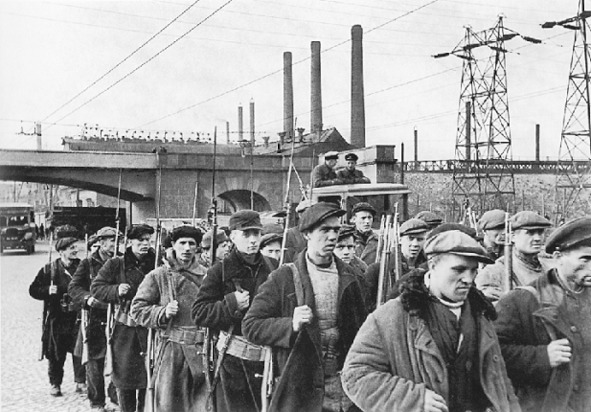
A part of workers not engaged in military production is sent to the front. Photography – workers of the Kirov factory. The line of fortifications is sometimes only 5—7 kilometers from important industrial sites, and 16 km. from the Winter Palace… N. Nikulin: «… The houses were transformed. Everywhere, the glass of the windows was crossed crosswise with strips of paper. Storefronts were scored and covered with sandbags. Inscriptions appeared on the walls – signs of bomb shelters and shelters. Observers were on duty on the roofs. Anti-aircraft guns were installed in the gardens, and some not-so-young people in wide ski pants marched there from morning to evening and were stuffed with bayonets. On the streets, girls in ridiculous riding breeches and poorly made tunics appeared every now and then. They carried monstrously sized gas balloons for barrage balloons that rose above the city on long cables. Recalling the huge fish, they clearly loomed in the cloudless sky of the white nights. And the war, meanwhile, was going on somewhere. Something was happening, but no one really knew anything. In the hospital began to bring the wounded, mobilized left and left. The scene of the sending of marines ran into the memory: right in front of our windows overlooking the Neva River, soldiers fully armed and equipped were loaded onto a pleasure boat. They quietly waited for their turn, and suddenly a woman ran up to one of them with a loud cry. She was persuaded, reassured, but without success. The soldier was tearing his hands together convulsively, and she continued to cling to the duffel bag, the rifle, the gas mask bag. The boat swam away, and the woman howled for a long time, banging her head against the granite parapet of the embankment. She felt what I learned much later: neither the soldiers, nor the boats, on which they were sent to the landing, no longer returned.»




